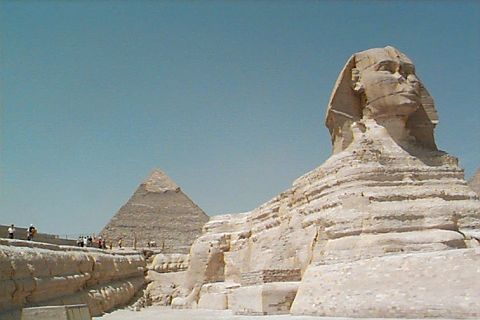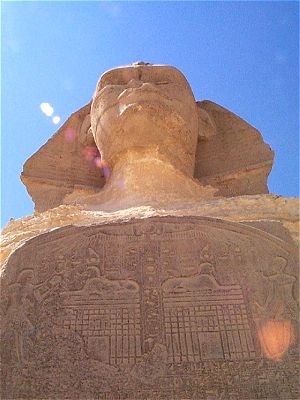

 |
| The most popular and current theory of the
builder of the Sphinx holds that it was
commisioned by the 4th Dynasty King, Khafre. Khafre was one of the sons of Khufu (AKA Cheops) who is recognized as the builder of the Great Pyramid. The Sphinx lines up with the Pyramid of Khafre at the foot of its causeway. Carved from the bedrock of the Giza plateau, the Sphinx is truly a mysterious marvel from the days of ancient Egypt. The body of a lion with the head of a king or god, the sphinx has come to symbolize strength and wisdom. the body of the Sphinx has been buried several times over the past several thousand years. Most recently in 1905, the sand has been cleared away to expose the magnitude and beauty of the entirety of the Sphinx. The paws themselves are 50 feet long (15m) while the entire length is 150 feet (45m). The head is 30 (10m) feet long and 14 feet (4m) wide. Because certain layers of the stone are softer than others, there is a high degree of erosion that has claimed the original detail of the carved figure. Although the head of the Sphinx is badly battered in some places, traces of the original paint can still be seen near one ear. Originally it is believed that the Sphinx was painted and was quite colorful. Since then, the nose and beard have been broken away. The nose was the unfortunate victim of target practice by the Turks in the Turkish period. It is often erroneously assumed that the nose was shot off by Napolean's men, but 18th century drawings reveal that the nose was missing long before Napolean's arrival. |
 |
| In between the paws of the Sphinx is a stela,
now called the "Dream Stela", which is inscribed with a story.
The 18th Dynasty story tells of the time that Thutmosis IV fell asleep under the Sphinx which was covered to the neck in sand. Thutmosis had a dream that the Sphinx spoke to him and promised that if he would free the Sphinx from the sand, Thutmosis would be destined to become king of Egypt. |
 |
 |
 |